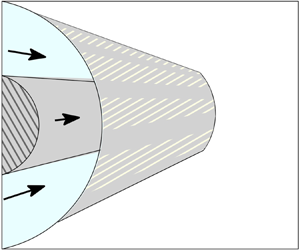Article contents
Superhydrophobic annular pipes: a theoretical study
Published online by Cambridge University Press: 13 November 2020
Abstract

Analytical solutions are presented for longitudinal flow along a superhydrophobic annular pipe where one wall, either the inner or outer, is a fully no-slip boundary while the other is a no-slip wall decorated by a rotationally symmetric pattern of no-shear longitudinal stripes. Formulas are given for the effective slip length associated with laminar flow along the superhydrophobic pipe and the friction properties are characterized. It is shown how these new solutions generalize two solutions to mixed no-slip/no-shear boundary value problems due to Philip (Z. Angew. Math. Phys., vol. 23, 1972, pp. 353–372) for flow in a single-walled superhydrophobic pipe and a superhydrophobic channel. This is done by providing alternative representations of Philip's two solutions, including a useful new formula for the effective slip length for his channel flow solution. For a superhydrophobic annular pipe with inner-wall no-shear patterning there is an optimal pipe bore for enhancing hydrodynamic slip for a given pattern of no-shear stripes. These optimal pipes have a ratio of inner–outer pipe radii in the approximate range 0.5–0.6 and depending only weakly on the geometry of the surface patterning. Boundary point singularities are found to be deleterious to the slip suggesting that, in designing slippery pipes, maximizing the size of uninterrupted no-shear regions is preferable to covering the same surface area with a larger number of smaller no-shear zones. The results add to a list of analytical solutions to mixed boundary value problems relevant to modelling superhydrophobic surfaces.
JFM classification
- Type
- JFM Papers
- Information
- Copyright
- © The Author(s), 2020. Published by Cambridge University Press
References
REFERENCES
- 12
- Cited by





